An LTM device pool has suddenly been marked down by a monitor. The pool consists of members 10.0.1.1:443 and 10.0.1.2:443 and are verified to be listening. The affected virtual server is 10.0.0.1:80.
Which two tools should the LTM Specialist use to troubleshoot the associated HTTPS pool monitor via the command line interface? (Choose two.)
An LTM Specialist must perform a hot fix installation from the command line.
What is the correct procedure to ensure that the installation is successful?
An LTM Specialist is creating a custom EAV monitor.
In which directory should the LTM Specialist upload the script?
A device on the network is configured with the same IP address as the management address of the active LTM device, causing the management GUI to be inaccessible.
Which two methods should the LTM Specialist use to access the LTM device in order to change the management IP address? (Choose two.)
An FTP monitor is NOT working correctly.
Which three pieces of information does the LTM Specialist need to provide to ensure a properly working FTP monitor? (Choose three.)
Windows PC clients are connecting to a virtual server over a high-speed, low-latency network with no packet loss.
Which built-in client-side TCP profile provides the highest throughput for HTTP downloads?
-- Exhibit –

-- Exhibit --
Refer to the exhibit.
An LTM Specialist is troubleshooting a sync-failover group of three BIG-IP LTM devices. The command used is "tmsh run cm watch-devicegroup-device."
What does the output mean?
An LTM Specialist has installed a hotfix that updated the SCCP firmware package.
Which command will ensure that the host subsystem and SCCP reboot?
An LTM Specialist is troubleshooting an issue with a new virtual server. When connecting through the virtual server, clients receive the message "Unable to connect" in the browser, although connections directly to the pool member show the application is functioning correctly. The LTM device configuration is:
ltm virtual /Common/vs_https {
destination /Common/10.10.1.110:443
ip-protocol udp
mask 255.255.255.255
pool /Common/pool_https
profiles {
/Common/udp { }
}
translate-address enabled
translate-port enabled
vlans-disabled
}
ltm pool /Common/pool_https {
members {
/Common/172.16.20.1:443 {
address 172.16.20.1
}
}
}
What issue is the LTM Specialist experiencing?
An HTTP 1.1 application utilizes chunking.
Which header should be used to notify the client's browser that there are additional HTTP headers at the end of the message?
An LTM Specialist is troubleshooting an issue with a new virtual server. When connecting through the virtual server, clients receive the message "The connection was reset" in the browser, although connections directly to the pool member show the application is functioning correctly.
ltm pool srv1_https_pool {
members {
192.168.2.1:https{
address 192.168.2.1
}
}
}
ltm virtual https_example_vs {
destination 192.168.1.155:https
ip-protocol tcp
mask 255.255.255.255
pool srv1_https_pool
profiles {
http { }
tcp { }
}
snat automap
vlans-disabled
}
How should the LTM Specialist resolve this issue?
Which command should an LTM Specialist use on the command line interface to show the health of RAID array hard drives?
Given this as the first packet displayed of an ssldump:
2 2 1296947622.6313 (0.0001) S>CV3.1(74) Handshake
ServerHello
Version 3.1
random[32]=
19 21 d7 55 c1 14 65 63 54 23 62 b7 c4 30 a2 f0
b8 c4 20 06 86 ed 9c 1f 9e 46 0f 42 79 45 8a 29
session_id[32]=
c4 44 ea 86 e2 ba f5 40 4b 44 b4 c2 3a d8 b4 ad
4c dc 13 0d 6c 48 f2 70 19 c3 05 f4 06 e5 ab a9
cipherSuite TLS_RSA_WITH_RC4_128_SHA
compressionMethod NULL
In reviewing the rest of the ssldump, the application data is NOT being decrypted.
Why is ssldump failing to decrypt the application data?
-- Exhibit –
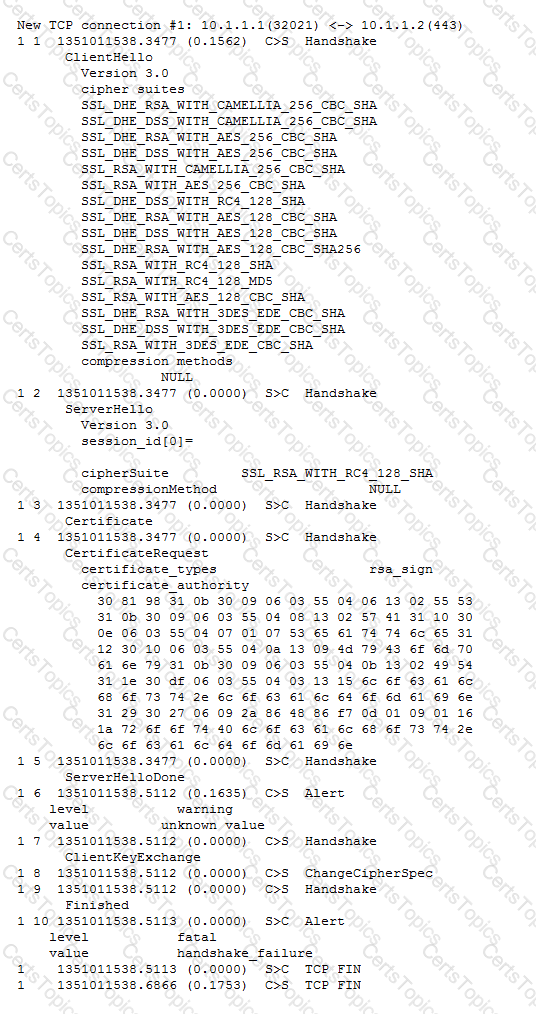
-- Exhibit --
Refer to the exhibit.
A user is unable to access a secure application via a virtual server.
What is the cause of the issue?
-- Exhibit –
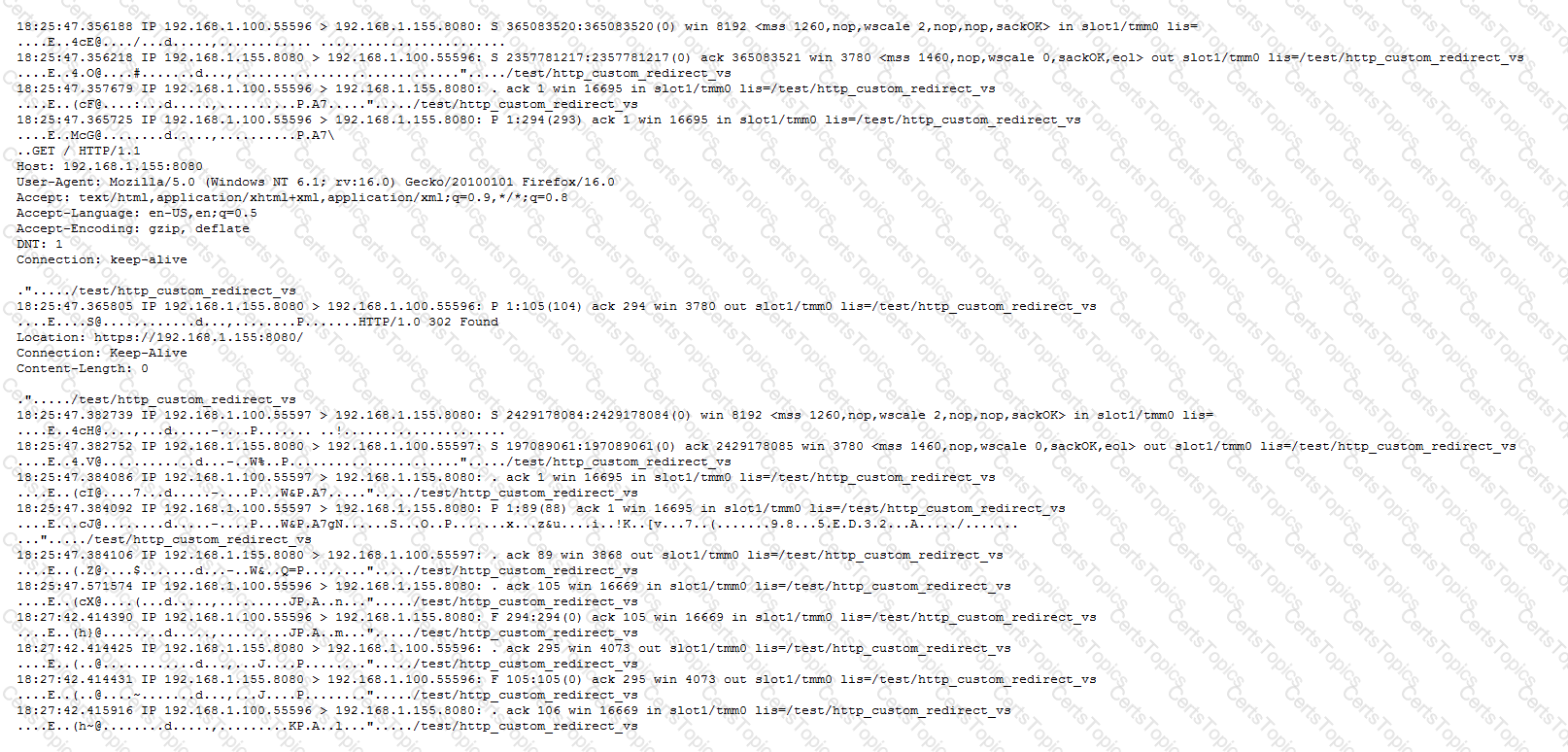
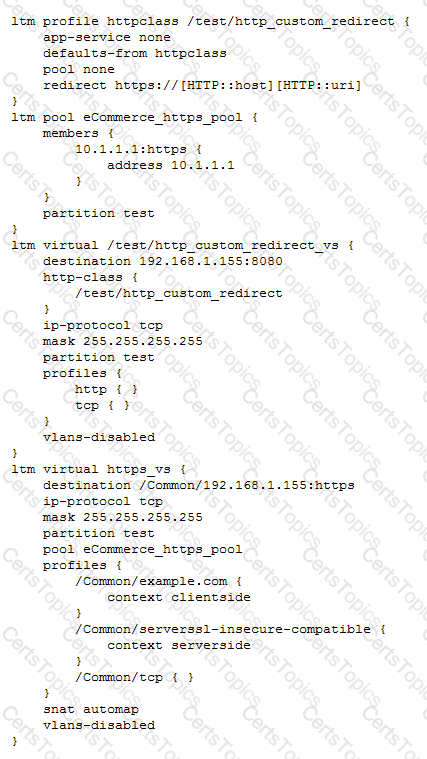
-- Exhibit --
Refer to the exhibits.
An LTM Specialist is reconfiguring a virtual server to redirect all clients to HTTPS. Testing reveals that the redirect is functioning incorrectly. As part of the troubleshooting process, the LTM Specialist performs a packet capture.
What is the issue?
A failover event is recorded in the log messages:
Jan 01 00:00:50 BIG-IP notice sod[5855]: 01140029:5: HA proc_running tmm fails action is go offline and down links.
Jan 01 00:00:50 BIG-IP notice sod[5855]: 010c0050:5: Sod requests links down.
Jan 01 00:00:50 BIG-IP notice sod[5855]: 010c0054:5: Offline for traffic group /Common/traffic-group-1.
Jan 01 00:00:50 BIG-IP notice sod[5855]: 010c003e:5: Offline
Jan 01 00:00:50 BIG-IP notice logger: /usr/bin/tmipsecd --tmmcount 4 ==> /usr/bin/bigstart stop racoon
Jan 01 00:00:50 BIG-IP info lacpd[5502]: 01160016:6: Failover event detected. (Switchboard failsafe disabled while offline)
Jan 01 00:00:51 BIG-IP err bcm56xxd[5296]: 012c0010:3: Failover event detected. Marking external interfaces down. bsx.c(3633)
Jan 01 00:00:51 BIG-IP info bcm56xxd[5296]: 012c0015:6: Link: 1.1 is DOWN
Jan 01 00:00:56 BIG-IP notice mcpd[5318]: 0107143c:5: Connection to CMI peer 10.0.0.3 has been removed
Jan 01 00:00:56 BIG-IP notice mcpd[5318]: 0107143a:5: CMI reconnect timer: enabled
Jan 01 00:00:56 BIG-IP notice mcpd[5318]: 01071431:5: Attempting to connect to CMI peer 10.0.0.3 port 6699
What is the cause of the failover?
An LTM Specialist defines a receive string in the HTTP monitor and then assigns it to the HTTP pool. The monitor has an interval of 5 seconds and a timeout of 16 seconds.
If the receive string is NOT seen in the the HTTP payload after 20 seconds, how does the LTM device mark the monitor status?
-- Exhibit –


-- Exhibit --
Refer to the exhibits.
An LTM Specialist is troubleshooting an issue with one of the virtual servers on an LTM device, and all requests are receiving errors. Testing directly against the server generates no errors. The LTM Specialist has captured the request and response on both client and server sides of the LTM device.
What should the LTM Specialist do to fix this issue?
An LTM device is load balancing telnet and ssh applications in a client/server environment experiencing significant packet delay.
Which setting in the TCP profile should reduce the amount of packet delay?
Which command should the LTM Specialist use to determine the current system time?
Which two items can be logged by the Application Visibility Reporting analytics profile? (Choose two.)
The LTM Specialist is writing a custom HTTP monitor for a web application and has viewed the content by accessing the site directly via their browser. The monitor continually fails. The monitor configuration is:
ltm monitor http /Common/exampleComMonitor {
defaults-from /Common/http
destination *:*
interval 5
recv "Recent Searches"
send "GET /app/feed/current\?uid=20145 HTTP/1.1\\r\\nHost: gzip, deflate\\r\\nConnection: close\\r\\n\\r\\n"
time-until-up 0
timeout 16
}
A trace shows the following request and response:
Request:
GET /app/feed/current?uid=20145 HTTP/1.1
Host
Accept-Encoding gzip, deflate
Connection: close
Response:
HTTP/1.1 302 Moved Temporarily
Date Wed, 17 Oct 2012 18:45:52 GMT
Server Apache
Location
Content-Encoding gzip
Content-Type text/html;charset=UTF-8
Set-CookiE. JSESSIONID=261EFFBDA8EC3036FBCC22D991AC6835; Path=/app/feed/current?uid=20145
What is the problem?
A web application requires knowledge of the client's true IP address for logging and analysis purposes. Instances of the application that can decode X-Forwarded-For HTTP headers reside in pool_a, while pool_b instances assume the source IP is the true address of the client.
Which iRule provides the proper functionality?
Which iRule statement demotes a virtual server from CMP?
-- Exhibit –
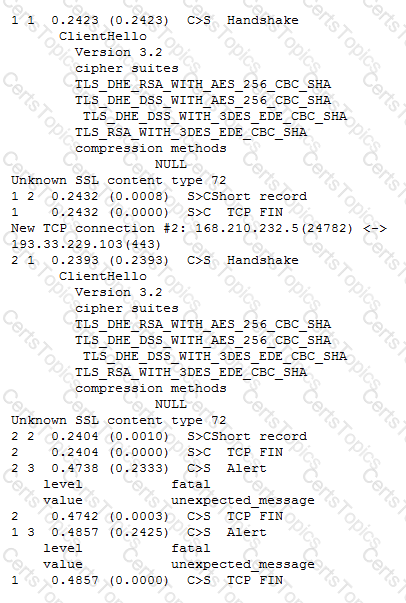
-- Exhibit --
Refer to the exhibit.
A client attempts to connect from a Google Chrome browser to a virtual server on a BIG-IP LTM. The virtual server is SSL Offloaded. When the client connects, the client receives an SSL error. After trying Mozilla Firefox and Internet Explorer browsers, the client still receives the same errors.
The LTM Specialist does an ssldump on the virtual server and receives the results as per the exhibit.
What is the problem?
-- Exhibit –
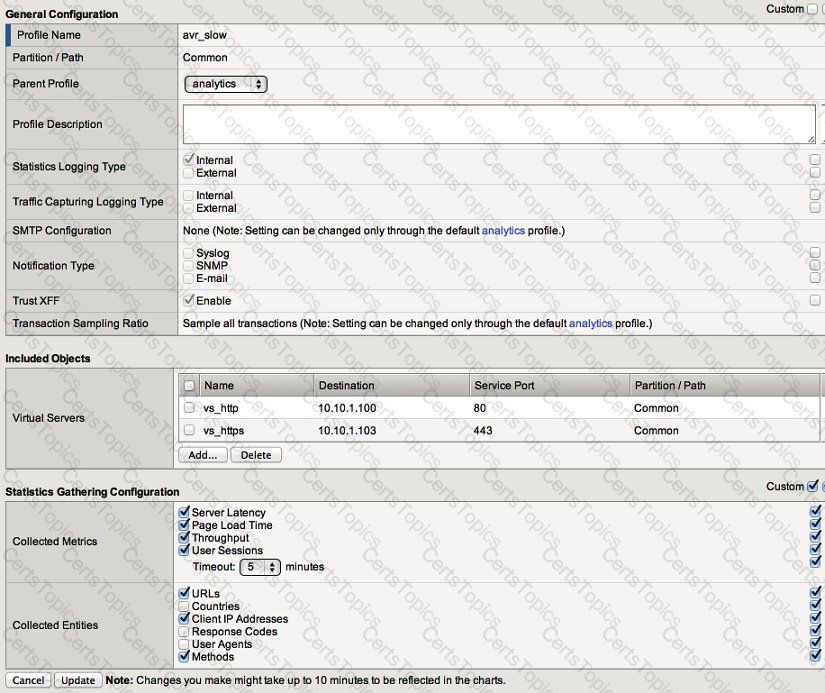
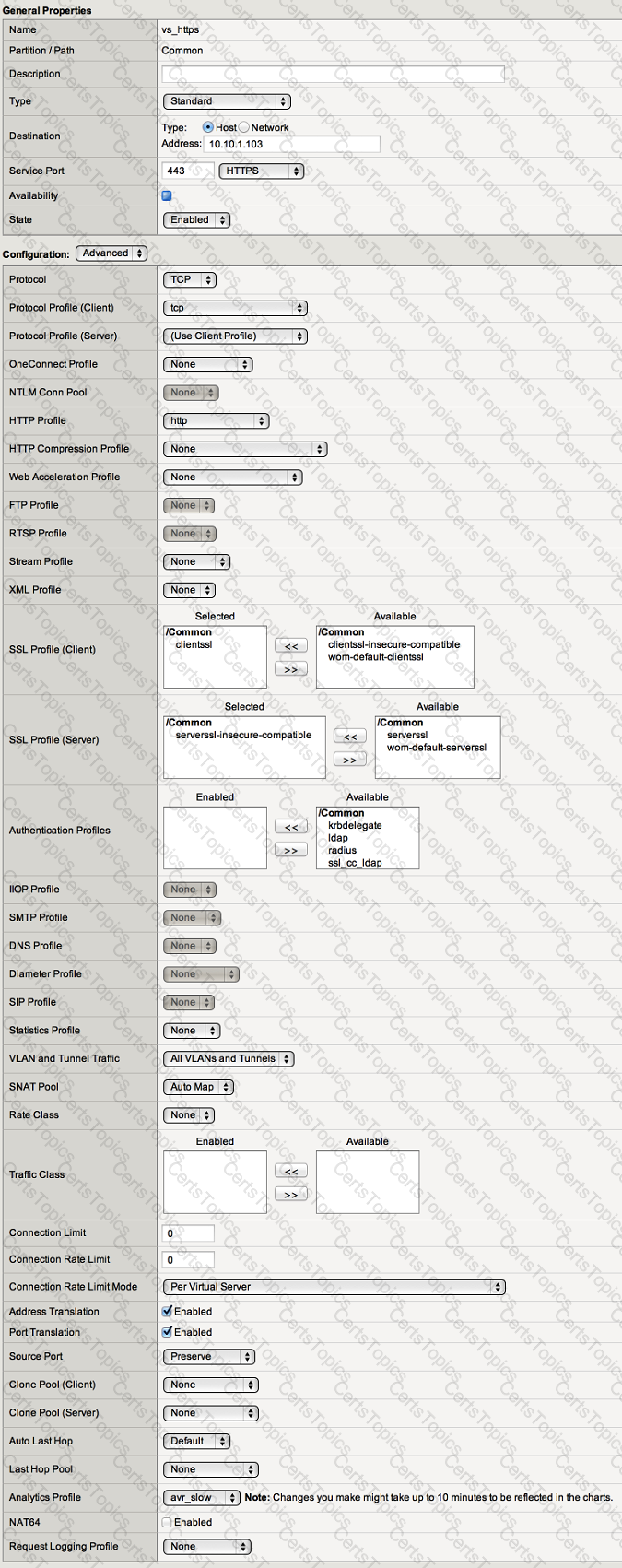
-- Exhibit --
Refer to the exhibits.
When observing the AVR statistics for the HTTPS_VS, an LTM Specialist realizes that HTTP status codes are NOT being recorded.
How should the LTM Specialist modify the configuration to record the HTTP status codes?
-- Exhibit –
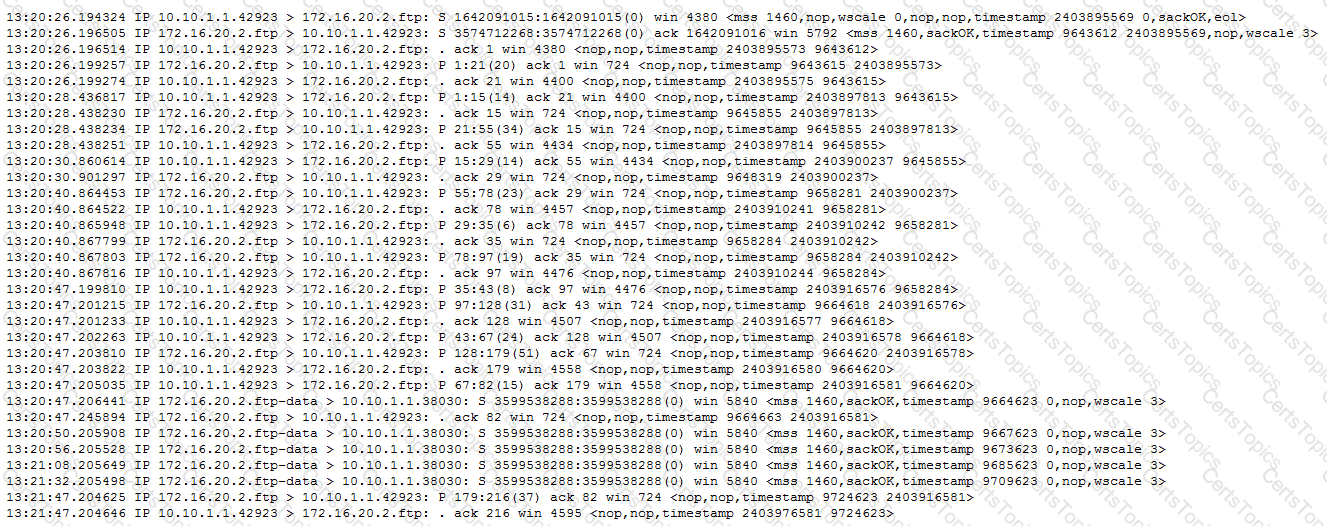
-- Exhibit --
Refer to the exhibit.
An LTM Specialist configures a virtual server to load balance to a pool of FTP servers. File transfers are failing. The virtual server is configured as follows:
ltm virtual ftp_vs {
destination 10.10.1.103:ftp
ip-protocol tcp
mask 255.255.255.255
pool ftp_pool
profiles {
tcp { }
}
vlans-disabled
}
Which change will resolve the problem?
An application is configured on an LTM device:
Virtual server: 10.0.0.1:80 (VLAN vlan301)
SNAT IP: 10.0.0.1
Pool members: 10.0.1.1:8080, 10.0.1.2:8080, 10.0.1.3:8080 (VLAN vlan302)
Which packet capture should the LTM Specialist perform on the LTM device command line interface to capture only client traffic specifically for this virtual server?
A BIG-IP Operator has made a grave error and deleted a few virtual servers on the active LTM device fronting the web browsing proxies. The BIG-IP Operator has NOT yet performed a configuration sync.
Which command should the LTM Specialist execute on the active LTM device to force a failover to the standby node and restore web browsing?
-- Exhibit –
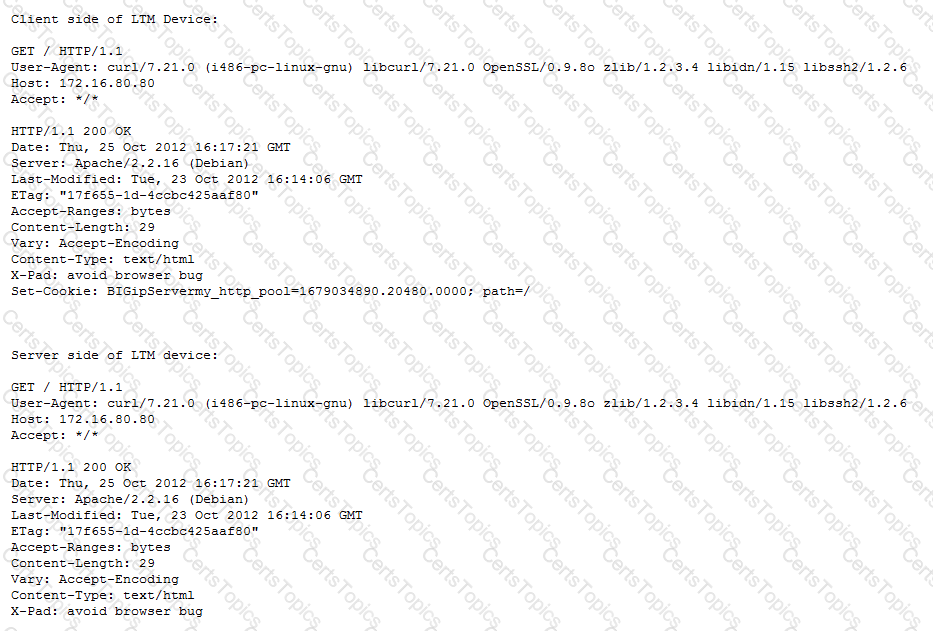
-- Exhibit --
Refer to the exhibit.
A web application is configured to allow sessions to continue even after a user computer is shut down for the night. A new LTM device is configured to load balance the web application to several servers. The application owner reports that application users are logged out of the web application whenever their browser is restarted or computer is rebooted.
What is the problem?
-- Exhibit --
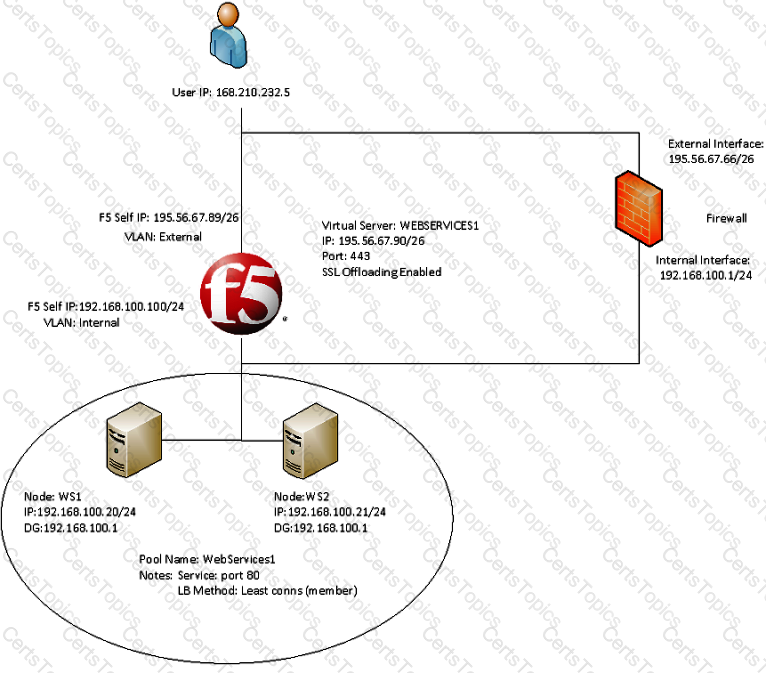
-- Exhibit --
Refer to the exhibit.
A company uses a complex piece of client software that connects to one or more virtual servers (VS) hosted on an LTM device. The client software is experiencing issues. An LTM Specialist must determine the cause of the problem.
The LTM Specialist is seeing a client source IP of 168.210.232.5 in the tcpdump. However, the client source IP is actually 10.123.17.12.
Why does the IP address of 10.123.17.12 fail to appear in the tcpdump?